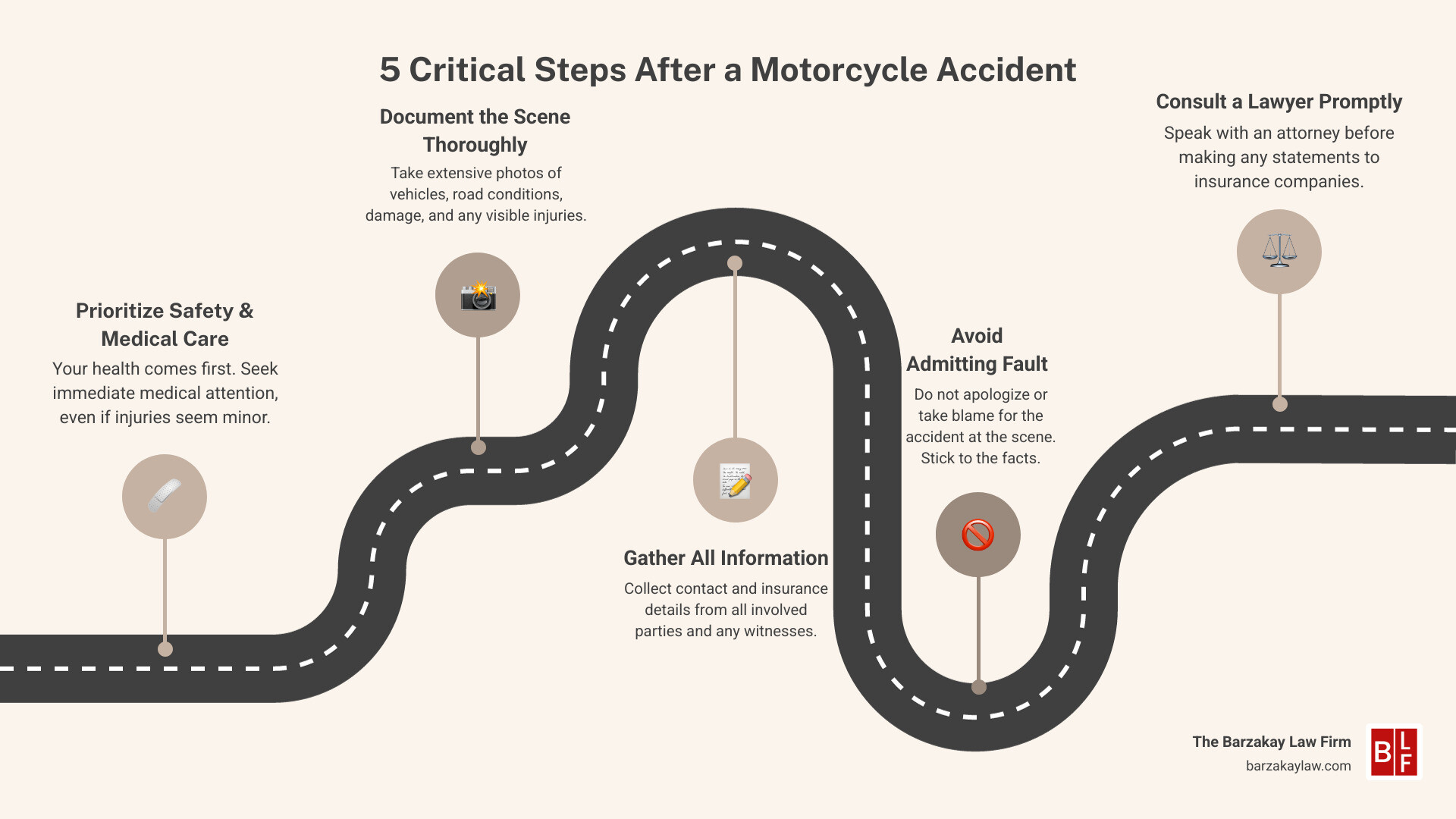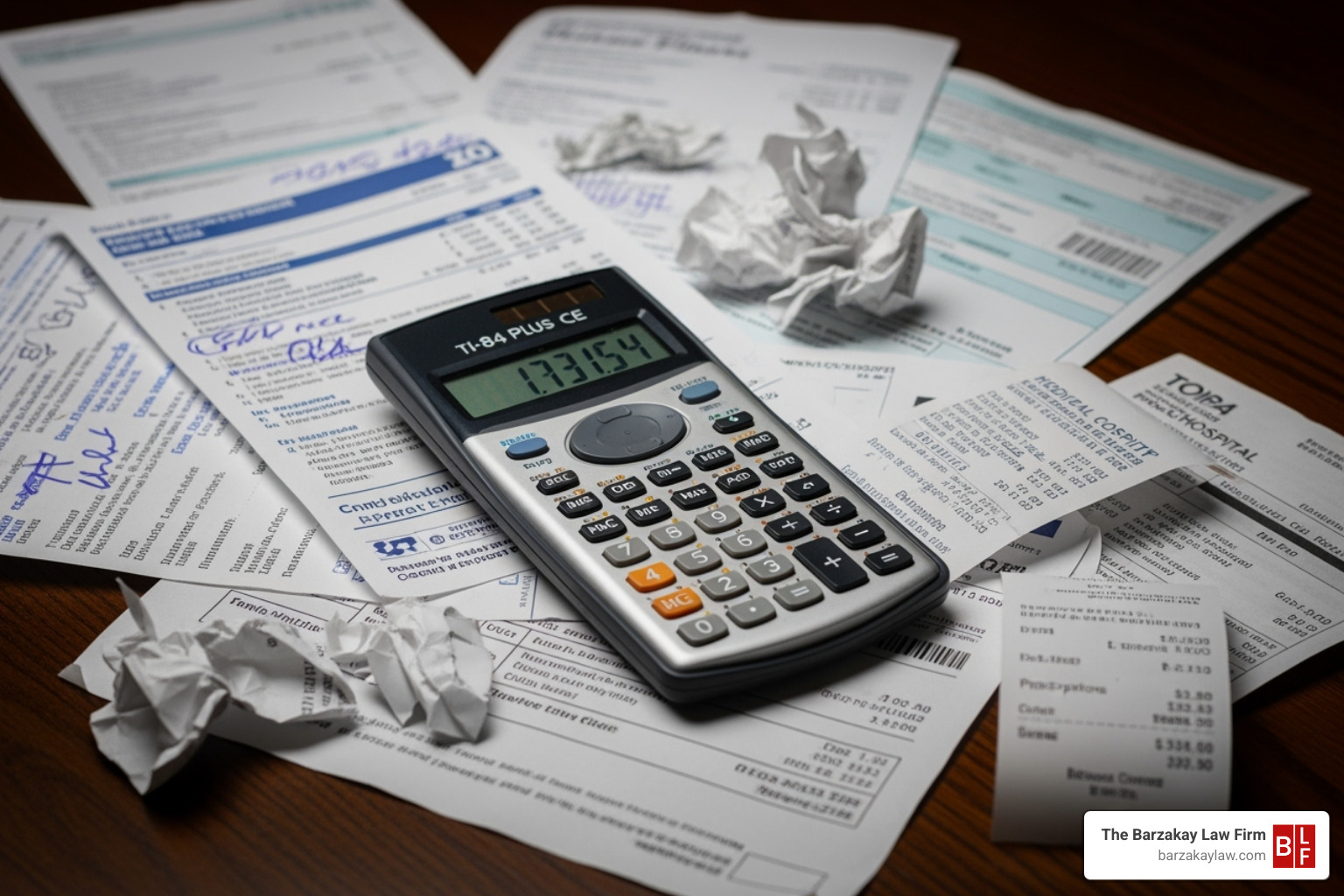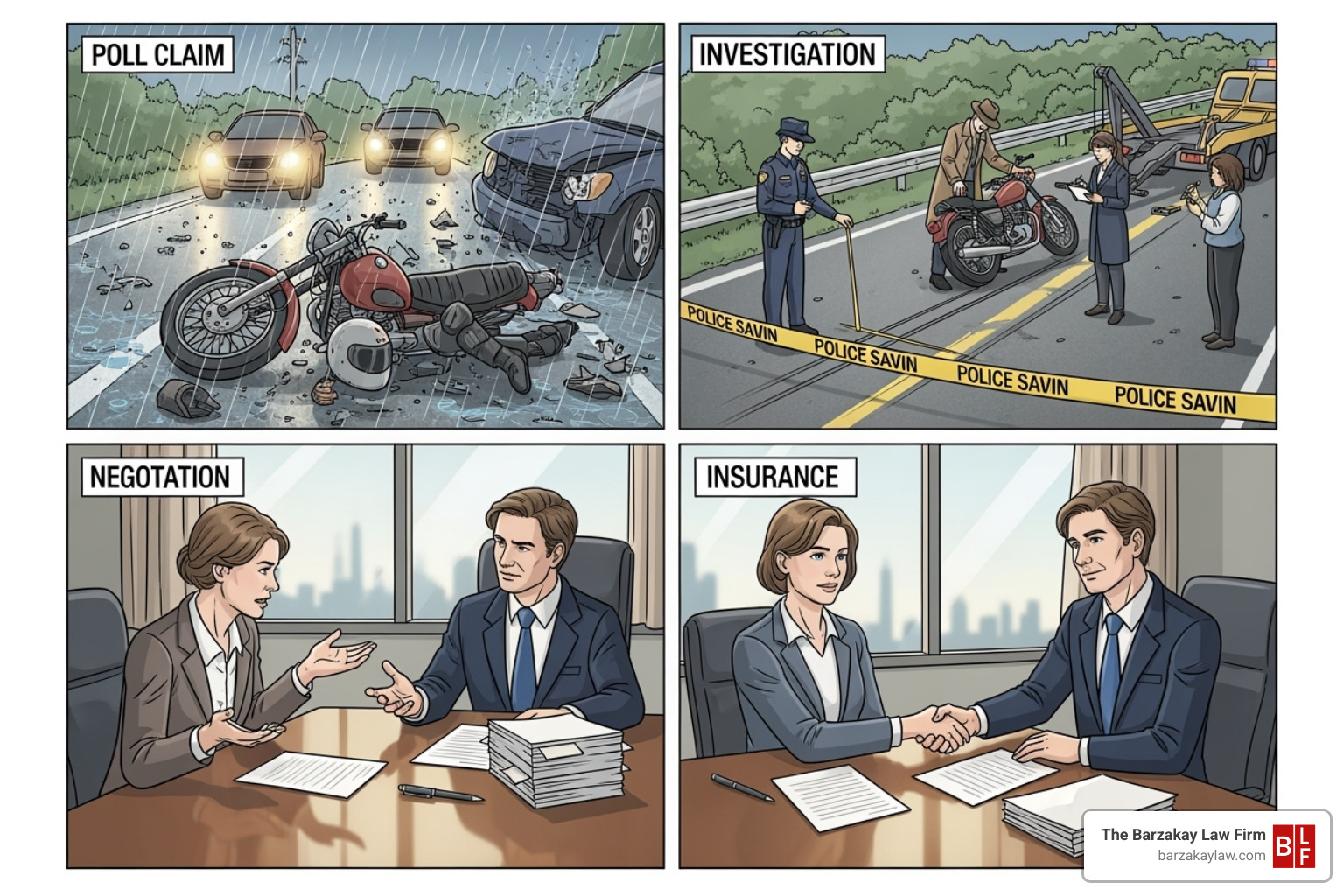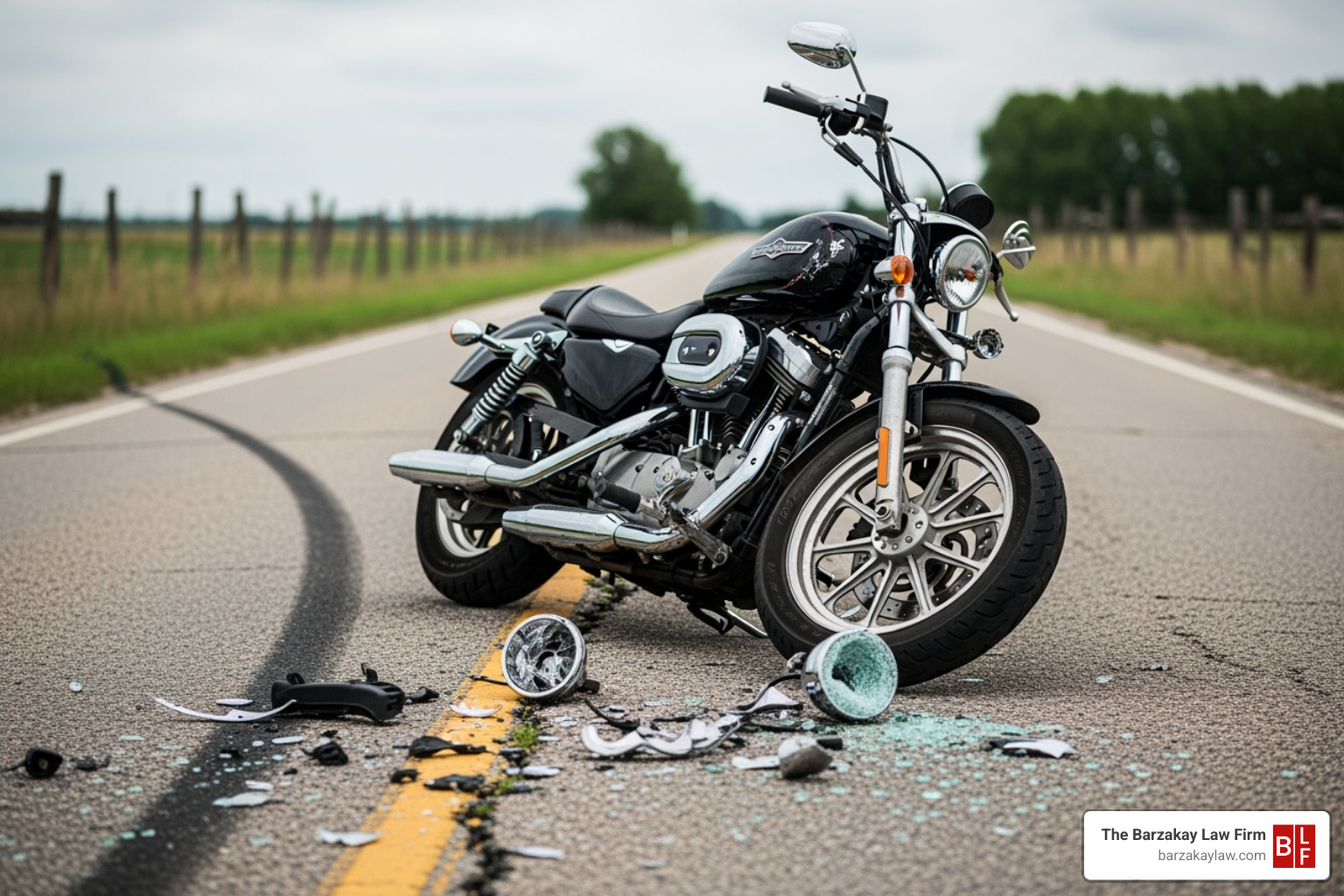Understanding Your Motorcycle Accident Injury Claim
A motorcycle accident injury claim can feel overwhelming. After a crash, you have a lot on your mind. But knowing what to do right away is key to protecting your future.
Here’s a quick overview of immediate steps to protect your claim:
- Prioritize Safety & Seek Medical Attention: Your health comes first. Get checked by a doctor, even if you feel fine.
- Document the Scene: Take photos of everything – vehicles, road conditions, injuries.
- Gather Information: Get contact and insurance details from others involved and any witnesses.
- Avoid Admitting Fault: Don’t apologize or take blame.
- Consult a Lawyer: Talk to an attorney before speaking with insurance companies.
Motorcyclists are very vulnerable on the road. They face unique dangers compared to drivers in cars. In fact, motorcyclists are 29 times more likely to be killed in a crash than passenger vehicle occupants. There’s also an 80% chance a rider will be physically hurt in an accident.
When a crash happens, the path to recovery can be complex. You might be dealing with serious injuries, lost income, and overwhelming medical bills. Understanding your rights and the steps involved in an injury claim is crucial.
This guide will walk you through the process. We’ll cover everything from what to do at the scene to how to get the financial help you need. Our goal is to help you steer this difficult time with confidence.
Critical Steps to Take Immediately After a Crash
The moments after a motorcycle accident are critical. Your actions can significantly impact your health and your ability to recover compensation. Here’s what to do:
- Ensure Safety & Call 911: If you can, move to a safe location. Immediately call 911 to report the accident and request medical assistance. An official police report is a crucial piece of evidence for your motorcycle accident injury claim.
- Seek Immediate Medical Attention: Even if you feel fine, see a doctor. Adrenaline can mask serious injuries. Delaying medical care can not only harm your health but also give the insurance company a reason to deny your claim.
- Document Everything: Use your phone to take photos and videos of the scene, including vehicle damage, road conditions, and your injuries. This visual evidence is invaluable.
- Gather Information: Exchange contact and insurance details with the other driver(s). If there are witnesses, get their names and phone numbers.
- Be Careful What You Say: Do not admit fault or apologize. Stick to the facts when speaking with the police. Avoid speaking with the other party’s insurance company, as they may use your words against you.
- Preserve Evidence & Follow Medical Advice: Keep all accident-related documents, including medical bills, repair estimates, and records of lost wages. Follow your doctor’s treatment plan diligently.
- Consult a Lawyer: Contact a motorcycle accident lawyer as soon as possible. An experienced attorney can protect your rights, handle communications with insurance companies, and guide you through the claims process, allowing you to focus on your recovery.
How Fault is Determined in a Motorcycle Accident
Figuring out who is at fault is the core of any motorcycle accident injury claim. In legal terms, this means proving “negligence”—that another party’s carelessness caused your injuries. To do this, we must show they had a duty to act safely, breached that duty, and that this breach directly caused your damages (injuries, lost wages, etc.).
Evidence like police reports, witness statements, and accident reconstruction analysis helps establish fault. Common causes of motorcycle accidents include:
- Distracted Driving: Drivers texting, talking, or otherwise not paying attention.
- Failure to Yield: Cars making left turns in front of motorcycles or pulling out into traffic.
- Unsafe Lane Changes: Drivers not checking blind spots.
- Impaired Driving: Operating a vehicle under the influence of alcohol or drugs.
- Road Hazards: Poorly maintained roads with potholes or debris.
The Role of Comparative Negligence
What if you, as the motorcyclist, were also partly at fault for the accident? This is where the idea of “comparative negligence” comes in, and it’s very important for your motorcycle accident injury claim.
Most states, including Florida and California, use some form of comparative negligence. This system allows injured people to still get compensation, even if they were partly responsible. Your total compensation is just reduced by your percentage of fault. For example, in California, which uses “pure comparative negligence,” if your damages are $100,000, but you were found 20% at fault, you could still recover $80,000. Florida, however, uses “modified comparative negligence.” This means you can recover damages as long as you aren’t more than 50% at fault. If you’re found 51% or more responsible, you generally can’t get any compensation at all. Understanding [How states handle shared fault](https://dictionary.nolo.com/comparative-negligence-term.html) is key because it directly impacts how much money you might receive.
How State-Specific Laws Impact Your Claim
Beyond comparative negligence, other specific state laws can also play a big role in your motorcycle accident injury claim.
Helmet Laws: Helmet laws are different in every state. In California, for example, there’s a “universal helmet law,” meaning everyone on a motorcycle must wear a DOT-approved helmet.
[Example of a state helmet law](https://law.justia.com/codes/california/2021/code-veh/division-12/chapter-5/article-7/section-27803/)shows this clearly. In Florida, if you’re over 21, you can ride without a helmet if you have at least $10,000 in medical insurance coverage. While not wearing a helmet might not make you at fault for the accident itself, it can affect your claim’s value if you suffer head injuries.Lane-Splitting Rules: California is unique because it’s one of the few states where “lane-splitting” (riding a motorcycle between lanes of stopped or very slow traffic) is legal. Many other states consider this illegal or have strict rules about it. If you’re in an accident while lane-splitting where it’s against the law, it could be used to argue you were partly at fault.
Traffic Violations: Any traffic tickets or violations given to either person involved in the accident will heavily influence who is considered responsible. This can really change the outcome of your motorcycle accident injury claim.
Calculating the Value of Your Motorcycle Accident Injury Claim
After a motorcycle accident, it’s completely natural to wonder, “What is my motorcycle accident injury claim actually worth?” The answer isn’t a simple, one-size-fits-all calculation. Every situation is unique, and your claim’s value depends on many factors specific to you and your accident. But generally, we look at two main types of damages: those you can easily put a price tag on, and those that are more about how the accident has impacted your life.
First, let’s talk about economic damages. These are your clear, quantifiable losses – the bills and receipts that pile up after a crash. Think of them as the direct financial hit. This includes things like all your past, present, and even future medical expenses, such as hospital stays, surgeries, medications, and physical therapy. It also covers the income you’ve lost because you couldn’t work due to your injuries, and even your future ability to earn a living if your injuries prevent you from doing the job you once could. Don’t forget the cost to repair or replace your damaged motorcycle and any other belongings that were hurt in the accident.
Then there are non-economic damages. These are a bit more personal and subjective, but just as real. They compensate you for the intangible ways your life has changed. This can include the physical pain and emotional distress you’ve experienced, like anxiety, depression, or even PTSD after a traumatic event. It also covers the loss of enjoyment of life – perhaps you can no longer participate in hobbies or activities you once loved. If you’ve been left with scarring or disfigurement, or even just daily inconveniences because of your injuries, these are also considered.
Several key factors will heavily influence the overall settlement value of your motorcycle accident injury claim. The severity of your injuries is often the biggest factor. Catastrophic injuries, like traumatic brain injuries or spinal cord injuries, usually lead to much higher claims because they involve extensive medical care, long-term needs, and a significant impact on your daily life. The insurance policy limits of the at-fault driver also play a big role; you generally can’t recover more than their policy allows. If their coverage isn’t enough, we might look into other options, like your own uninsured or underinsured motorist (UM/UIM) coverage. The strength of your evidence is crucial too – a well-documented case with clear proof of who was at fault and how you were damaged will always lead to a better outcome. And finally, having strong legal representation can truly make a difference. Studies often show that people who work with a personal injury attorney receive much more compensation than those who try to handle their claims alone. We’re here to level the playing field against insurance companies whose main goal is to pay out as little as possible.
Types of Damages You Can Recover
When we work on your motorcycle accident injury claim, our goal is to recover every possible dollar you’re entitled to because of the accident. It’s about making you whole again, as much as money can. Here’s a list of what you can typically claim:
- Medical expenses (both what you’ve already paid and what you’ll need in the future)
- Lost wages (income you missed out on)
- Loss of earning capacity (if your ability to earn money in the future is affected)
- Property damage (for your motorcycle and other belongings)
- Pain and suffering (for physical pain and emotional distress)
- Emotional distress (anxiety, depression, PTSD)
- Loss of enjoyment of life (inability to do things you once loved)
- Disfigurement and inconvenience
- Punitive damages (in rare cases where the other party’s actions were extremely reckless or malicious)
Figuring out future medical costs and lost earning potential can be quite complex. It often involves working with medical and financial professionals to project what your long-term needs and financial impacts will be. For example, if your injury means you have to change careers or can’t work as much, we’ll calculate the difference in your projected lifetime earnings. We focus on [How to maximize your settlement](https://barzakaylaw.com/blog/maximize-miami-vehicle-accident-settlement-legal-tips/) by carefully documenting all your losses and fighting hard on your behalf.
Understanding Average Settlement Amounts
It’s very common to wonder about “average” settlement amounts for a motorcycle accident injury claim. While some general statistics can give you a ballpark idea, it’s really important to remember that there’s no true “average” because every single case is completely unique. Your claim’s value will depend entirely on the specific facts, your particular injuries, and all the losses you’ve suffered.
However, based on general trends, we can give you some rough ranges for motorcycle accident injury claim settlements in California:
- For minor injuries, where perhaps you’ve had soft tissue damage, road rash, or minor fractures with a full recovery, settlements typically range from around $10,000 to $25,000.
- For moderate injuries, which might include more significant fractures, some internal injuries, or moderate concussions requiring a longer recovery period, settlements often fall between $25,000 and $200,000.
- For severe injuries, like traumatic brain injuries, spinal cord injuries, or amputations that often lead to permanent disability or major life changes, settlement amounts can be $200,000 and upwards of $500,000.
It’s also interesting to note the difference between cases that settle out of court and those that go to trial. The general statistics show that the average motorcycle accident settlement in California is approximately $75,000 for riders whose cases proceed to trial, compared to about $10,000 – $25,000 for those who settle without litigation. This doesn’t mean going to trial always gets you more; it often reflects that the more complex or higher-value cases are the ones that end up in court. The good news is that the vast majority of personal injury cases, including motorcycle accidents (around 97%), are settled during the insurance claim stage without ever needing a trial.
These figures are just general guidelines, of course. Your motorcycle accident injury claim will be carefully valued based on its own specific details and merits.
The Claim Process: From Initial Report to Final Resolution
Navigating a motorcycle accident injury claim can feel like a long and winding road, but understanding the typical process can help ease some of the uncertainty. Here’s a general overview of how a claim unfolds, from the initial report to its final resolution:
- Initial Report & Investigation: The accident is reported to the insurance companies, who then begin their own investigations. This involves reviewing police reports, witness statements, and medical records.
- The Role of the Insurance Adjuster: The at-fault party’s insurance adjuster will evaluate your claim. Their job is to protect their company’s bottom line, which often means trying to pay as little as possible. They might question your injuries, delay communications, or make lowball offers. This is precisely why having legal representation is so important.
- Demand Letter: Once you’ve reached maximum medical improvement (meaning your doctors believe your condition won’t improve further), we will compile all your medical records, bills, lost wage statements, and other documentation. We then send a comprehensive demand letter to the at-fault party’s insurance company, outlining your damages and demanding a specific amount for settlement.
- Negotiation: The insurance company will likely respond with a counter-offer, which is often much lower than our demand. This begins the negotiation process. We go back and forth, presenting evidence and arguments to support our valuation, working to get you a fair settlement.
- Settlement or Litigation: If negotiations are successful, both parties agree on a settlement amount. You sign a release of liability, meaning you agree not to pursue further action against the at-fault party for this accident. If negotiations fail to yield a fair offer, we may advise filing a lawsuit. This moves the case into formal litigation, which involves findy (exchanging information and evidence), potentially mediation, and ultimately, if no settlement is reached, a trial.
Settling Your Claim vs. Going to Trial
Deciding whether to settle your motorcycle accident injury claim or go to trial is a significant choice. As we mentioned, most cases settle without ever seeing a courtroom (around 97% of personal injury cases).
Settling a claim is generally faster, less stressful, and provides a guaranteed outcome. You have control over the final amount and can receive your compensation sooner. However, the settlement amount might be less than what you could potentially win at trial.
Going to trial offers the possibility of a larger award from a jury, but it comes with risks. Trials are expensive, time-consuming, and the outcome is never certain. A jury could award you less than the final settlement offer, or nothing at all. We can help you weigh the pros and cons and make an informed decision about whether to settle or go to trial.
The Importance of Legal Representation for Your Claim
Hiring an experienced motorcycle accident attorney is crucial for protecting your rights and maximizing your compensation. Insurance companies have teams of adjusters and lawyers working to minimize their payouts. An attorney levels the playing field.
Here’s how a lawyer helps:
- Handles All Communication: Prevents you from making recorded statements or accepting lowball offers that could hurt your case.
- Gathers Evidence: Thoroughly investigates the accident to build a strong claim.
- Accurately Values Your Claim: Works with professionals to calculate all your damages, including future medical needs and lost income.
- Negotiates on Your Behalf: Fights for the full and fair settlement you deserve.
- Manages Deadlines: Ensures all legal paperwork, including the statute of limitations, is filed correctly and on time.
Without legal guidance, it’s easy to make mistakes like settling too quickly, underestimating your damages, or missing critical deadlines. An attorney ensures your case is handled professionally, allowing you to focus on your recovery.
Common Mistakes to Avoid When Pursuing a Claim
To protect your motorcycle accident injury claim, avoid these common pitfalls:
- Accepting the First Offer: The first offer from an insurance company is almost always too low.
- Giving a Recorded Statement: You are not obligated to give a recorded statement to the other party’s insurer. It can be used against you.
- Signing Documents Without Review: Never sign any documents from an insurance company without having your lawyer review them first.
- Posting on Social Media: Insurance companies will look at your social media. A photo or post can be taken out of context and used to undermine your claim.
- Not Following Doctor’s Orders: This can be interpreted as your injuries not being as severe as you claim.
- Delaying Legal Action: States have strict deadlines, known as statutes of limitations, for filing a lawsuit. Missing this deadline can mean losing your right to compensation forever. For more information, read about common mistakes that can hurt your case.
Understanding Your Motorcycle Accident Injury Claim
Motorcyclists have very little protection in a crash, which is why the National Highway Traffic Safety Administration notes they are 29 × more likely to die and far more likely to be hurt than people in passenger cars. Understanding the claim process
gives you the greatest chance of covering medical bills, lost income and other losses while you heal. The following sections show how to protect your health, collect evidence and pursue fair compensation through The Barzakay Law Firm.
How Fault is Determined in a Motorcycle Accident
Establishing fault means proving another party acted negligently and that their actions directly caused your injuries. Evidence such as the police report, photos, witness statements and accident reconstruction helps show what really happened.
Common causes include:
- Distracted driving
- Failure to yield (especially left-hand turns)
- Unsafe lane changes
- Impaired driving
- Road hazards
The Role of Comparative Negligence
Most states let you recover damages even if you share some blame. In a “pure” system such as Californias, a 20 % fault finding simply reduces a $100,000 claim to $80,000. In Floridas modified system you must be 50 % or less at fault. More details: How states handle shared fault.
How State-Specific Laws Impact Your Claim
- Helmet laws vary. Not wearing one where it is required can reduce payment for a head injury. See an example of a state helmet law.
- Lane-splitting rules differ; doing it illegally can increase your share of fault.
- Traffic citations given to either party may strongly influence liability findings.
Calculating the Value of Your Motorcycle Accident Injury Claim
Your payout depends on two damage categories:
- Economic damages – the bills you can count (medical care, lost wages, motorcycle repairs, future treatment).
- Non-economic damages – harder-to-measure losses such as pain, emotional distress and loss of enjoyment of life.
Key factors shaping the final figure include injury severity, insurance policy limits, quality of evidence and whether you have legal counsel. See tips on how to maximize your settlement.
Types of Damages You Can Recover
- Medical expenses (past / future)
- Lost wages
- Loss of earning capacity
- Property damage
- Pain and suffering
- Emotional distress
- Loss of enjoyment of life
- Disfigurement and inconvenience
- Punitive damages (in rare, egregious cases)
Typical Settlement Ranges (California example)
- Minor injuries: $10,000 – $25,000
- Moderate injuries: $25,000 – $200,000
- Severe injuries: $200,000 – $500,000+
Most claims (about 97 %) settle before trial; higher-value or disputed cases are the ones that usually proceed to court.
The Claim Process: From Initial Report to Final Resolution
- Notify both insurers and cooperate with their investigations.
- Reach maximum medical improvement so your future costs are clear.
- Your lawyer drafts a demand letter summarizing evidence and losses.
- Negotiations begin; most end with an agreed settlement and a release of liability.
- If talks stall, your attorney may file suit and move toward mediation or trial.
Settling vs. Going to Trial
Settlements are faster and guaranteed, while trials carry higher risk but can yield larger verdicts. Your attorney will explain the pros and cons so you can decide whether to settle or go to trial.




